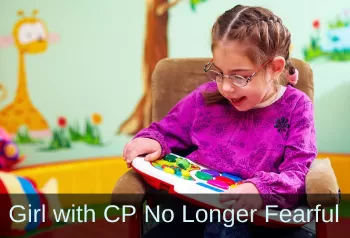Cerebral Palsy
Can Rhythmic Movements and Reflex Integration Help with Cerebral Palsy?
by Sonia Story, M.S.
Dr. Harald Blomberg had extensive experience using rhythmic movements and primitive reflex integration for children with cerebral palsy. Because these children were often stuck in tension patterns, reflex patterns, and had overall poor core strength, Blomberg found it important for children with cerebral palsy to have time on the floor doing targeted rhythmic and reflex integration movements. He found these movements essential for reducing spasticity, developing core strength, and improving postural stability for functional movement. By developing the core foundation, Blomberg saw that sitting, walking, and other movements were less likely to be affected by compensatory movement patterns as the child progressed.
The study by Wagh et al. (2019), supports Blomberg's observations that primitive reflex integration can be helpful for boosting gross motor function in children with spastic cerebral palsy.
After doing these simple, enjoyable neurodevelopmental movements from the Brain and Sensory Foundations course, therapists are seeing that children with cerebral palsy are gaining more core strength, postural stability, quality of movement, functional skills, and emotional well being.
Enjoy these inspiring case studies showing progress for children with cerebral palsy.
This young boy with pachygyria, schizencephaly, and cerebral palsy has poor body control and core strength, as well as poor emotional regulation and a reluctance to try new skills. Find out how rhythmic movements introduced a calm that allowed him to improve his fine and gross motor skills.
This child's improved balance brought an unexpected benefit: increased focus and engagement with those around her because she now worries less about her physical safety. Read more about how neurodevelopmental movements made a difference for this child with cerebral palsy.
Over the course of 6 months, this young teen girl gained confidence and a great sense of accomplishment after completing tasks she hadn't been able to do before. Life-changing! Read the full case study to see how tools from the Brain and Sensory Foundations course helped this teen with CP.
It is rewarding to see the immense progress children can make with neurodevelopmental movements—see more case studies involving children with cerebral palsy.
Reference
Wagh, S. C., Malawade, M. R., & Vardharajulu, G. (2019). Effect of specific reflex Integration approach on primitive reflexes in spastic cerebral palsy children. International Journal of Health Sciences and Research, 9, 87-93.
Sonia Story, M.S. has been teaching neurodevelopmental movements since 2006.
Sonia developed the Brain and Sensory Foundations program to provide comprehensive training in neurodevelopmental movements—combining innate rhythmic movements, play, primitive reflexes, and postural reflexes.
She earned a Bachelor's degree in biology/psychology and a Master’s degree in Movement Sciences. She is the author of The Importance of Reflex Integration and the Evidence eBook, giving the rationale and evidence basis for using neurodevelopmental movements for helping with challenges such as ADHD, Sensory Processing Disorders, anxiety, emotional dysregulation, visual skill deficits, poor social skills, gross and fine motor delays and other neurodevelopmental and behavioral disorders.
Her work is featured in numerous podcasts, summits, and conferences, and in the books Almost Autism: Recovering Children from Sensory Processing Disorder; Special Ed Mom Survival Guide; Family Health Revolution; and Same Journey, Different Paths—Stories of Auditory Processing Disorder.
Sonia’s mission is to help children and families experience the profound benefits of neurodevelopmental and integrative movements for more functional and fulfilling lives.





